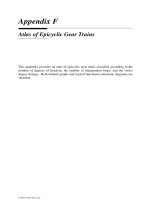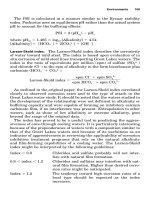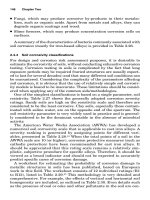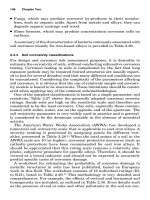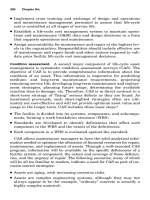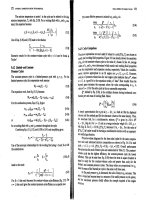Communication Systems Engineering Episode 1 Part 6 potx
Bạn đang xem bản rút gọn của tài liệu. Xem và tải ngay bản đầy đủ của tài liệu tại đây (216.47 KB, 25 trang )
Lectures 6&7 Modulation
Eytan Modiano
AA Dept.
Eytan Modiano
Slide 1
Modulation
• Representing digital signals as analog waveforms
• Baseband signals
– Signals whose frequency components are concentrated around zero
• Passband signals
– Signals whose frequency components are centered at some
frequency fc away from zero
• Baseband signals can be converted to passband signals through
modulation
– Multiplication by a sinusoid with frequency fc
Eytan Modiano
Slide 2
Baseband signals
• The simplest signaling scheme is pulse amplitude modulation (PAM)
– With binary PAM a pulse of amplitude A is used to represent a “1” and a
pulse with amplitude -A to represent a “0”
• The simplest pulse is a rectangular pulse, but in practice other type
of pulses are used
– For our discussion we will generally assume a rectangular pulse
• If we let g(t) be the basic pulse shape, than with PAM we transmit g(t)
to represent a “1” and -g(t) to represent a “0”
g(t)
1 => S(t) = g(t)
A
0 => S(t) = -g(t)
Tb
Eytan Modiano
Slide 3
M-ary PAM
• Use M signal levels, A
1
…A
M
– Each level can be used to represent Log
2
(M) bits
• E.g., M = 4 => A
1
= -3, A
2
= -1, A
3
= 1, A
4
= 3
– S
i
(t) = A
i
g(t)
• Mapping of bits to signals
Si b1b2
S
1
00
S
2
01
S
3
11
S
4
10
Eytan Modiano
Slide 4
gt
tT
Signal Energy
T T
E
m
=
∫
0
((t))
2
dt = ( A
m
)
2
∫
0
()
2
dt = ( A
m
)
2
E
g
S
m
g
t
• The signal energy depends on the amplitude
• E
g
is the energy of the signal pulse g(t)
• For rectangular pulse with energy E
g
=>
T
E
g
=
∫
0
A
2
dt = TA
2
=> A = E
g
2 /
g(t)
E
g
/ 2
0 ≤≤
() =
0
otherwise
E
g
/2
Eytan Modiano
T
Slide 5
Symmetric PAM
• Signal amplitudes are equally distant and symmetric about zero
-7
-5 -3
-1 0 1 3 5 7
A
m
= (2m-1-M), m=1…M
E
M
E
ave
=
g
∑
(2
m
− 1 −
M
)
2
=
E
g
(
M
2
− 1)/ 3
M
m =1
Eytan Modiano
Slide 6
Gray Coding
• Mechanism for assigning bits to symbols so that the number of bit
errors is minimized
– Most likely symbol errors are between adjacent levels
– Want to MAP bits to symbols so that the number of bits that differ
between adjacent levels is mimimized
• Gray coding achieves 1 bit difference between adjacent levels
• Example M= 8 (can be generalized)
A
1
000
A
2
001
A
3
011
A
4
010
A
5
110
A
6
111
A
7
101
Eytan Modiano
A
8
100
Slide 7
Bandpass signals
• To transmit a baseband signal S(t) through a bandpass channel
at some center frequency f
c
, we multiply S(t) by a sinusoid with
that frequency
S
m
(t)
U
m
(t)= S
m
(t)Cos(2πf
c
t)
= A
m
g(t) Cos(2πf
c
t)
Cos(2πf
c
t)
F[Cos(2πf
c
t)] = (δ(f-f
c
)+δ(f+f
c
))/2
Eytan Modiano
-f
c
f
c
Slide 8
Passband signals, cont.
F[A
m
g(t)] = depends on g()
A
m
-w
w
F[A
m
g(t) Cos(2πf
c
t)]
A
m
/2
A
m
/2
-f
c
f
c
Eytan Modiano
Slide 9
Recall: Multiplication in time = convolution in frequency
()
Energy content of modulated signals
∞ ∞
E
m
=
∫
−∞
U
2
t dt =
∫
−∞
A
m
g
2
()
m
()
2
t Cos
2
(
2
π
f
c
t
)
dt
Cos
2
α
=
1 +
cos(
2
α
)
2
A
2
∞
A
2
∞
2
()
+
2
m
∫
−∞
gt Cos
2
(
4
π
f
c
t
)
dtE
m
=
2
m
∫
−∞
gt
2
()
A
2
m
E = E + ≈ 0
m
2
g
• The cosine part is fast varying and integrates to 0
• Modulated signal has 1/2 the energy as the baseband signal
Eytan Modiano
Slide 10
Demodulation
• How do we recover the baseband signal?
U
m
(t)= S
m
(t)Cos(2πf
c
t)
= A
m
g(t) Cos(2πf
c
t)
U(t)
LPF S
r
(t)
2Cos(2πf
c
t)
U(t)2Cos(2πf
c
t)= 2S(t)Cos
2
(2πf
c
t) = S(t) + S(t)Cos(4πf
c
t)
The high frequency component is rejected by the LPF and we
are left with S(t).
Eytan Modiano
Slide 11
jf
Bandwidth occupancy
G(f) = F[g(t)]
g(t)
A
∞ T
Gf
2
π
() =
∫
−∞
g(t)e
− jft
dt =
∫
0
Ae
− j 2
π
ft
dt
Gf() = ( AT )Sinc(
π
fT )e
−
π
T
T
|G(f)|
AT
-2/T -1/T 1/T 2/T
• First “null” bandwidth = 2(1/T) = 2/T
Eytan Modiano
Slide 12
Bandwidth efficiency
• Rs = symbol rate = 1/T
– Log
2
(M) bits per symbol => Rb = bit rate = log
2
(M)/T bits per second
• BW = 2/T = 2Rs
– Bandwidth efficiency = Rb/BW = log
2
(M)/T * (T/2) = log
2
(M)/2 BPS/Hz
• Example:
– M=2 => bandwidth efficiency = 1/2
– M=4 => bandwidth efficiency = 1
– M=8 => bandwidth efficiency = 3/2
• Increased BW efficiency with increasing M
• However, as M increase we are more prone to errors as symbols are
closer together (for a given energy level)
– Need to increase symbol energy level in order to overcome errors
– Tradeoff between BW efficiency and energy efficiency
Eytan Modiano
Slide 13
Energy utilization
E
M
E
ave
=
g
∑
(
2m
−
1
−
M
)
2
=
E
g
(
M
2
−
1
)/
3
,
E
g
= basic pulse energy
M
m=1
2
g
( )/After modulation E
u
=
E
s
=
EM
2
−
16
E
b
= average energy per bit =
(M
2
−
1
)
E
g
6
Log
2
()
M
• Average energy per bit increases as M increases
BW efficiency
energy efficiency
Eytan Modiano
Slide 14
M
Two-dimensional signals
• S
i
= (S
i1
, S
i2
)
• Set of signal points is
called a constellation
S
1
=(1,1)
S
2
=(-1,-1)
S
3
=(1,-1)
S
4
=(-1,1)
• 2-D constellations are commonly used
• Large constellations can be used to transmit many bits per symbol
– More bandwidth efficient
– More error prone
• The “shape” of the constellation can be used to minimize error
probability by keeping symbols as far apart as possible
• Common constellations
– QAM: Quadrature Amplitude Modulation
PAM in two dimensions
Eytan Modiano
– PSK: Phase Shift Keying
Slide 15
Special constellation where all symbols have equal power
Symmetric M-QAM
x y x y
/
S
m
= ( A
m
, A
m
), A
m
, A
m
∈
{
+ / − 1, + / − 3, , +− ( M − 1)
}
M is the total number of signal points (symbols)
signal levels on each axis
M
16-QAM
Constellation is symmetric
⇒ M=K
2
, for some K
Signal levels on each axis are
the same as for PAM
Eg
x y
,4 − QAM ⇒ A
m
, A
m
∈
{
+ / − 1
}
x y
16 − QAM ⇒ A
m
, A
m
∈
{
+ / − 1, + / − 3
}
Eytan Modiano
Slide 16
-3 -1 1 3
-3
-1
1
3
Bandwidth occupancy of QAM
• When using a rectangular pulse, the Fourier transform is a Sinc
g(t)
|G(f)|
A
AT
T
-2/T -1/T 1/T 2/T
• First null BW is still 2/T
– K = Log
2
(M) bits per symbol
– Rb = Log
2
(M)/T
– Bandwidth Efficiency = Rb/BW = Log
2
(M)/2
– => “Same as for PAM”
Eytan Modiano
Slide 17
Energy efficiency
x y
E
sm
=
[(
A
m
)
2
+
(
A
m
)
2
]
E
g
x
EA
m
)
2
]
= EA
m
)
2
]
=
K
2
−
1
=
M −
1
,
K =
[( [(
y
3 3
M
E =
2
(
M −
1
)
E
s
3
g
Transmitted energy =
E
s
=
(
M
−
1
)
E
g
2 3
E
b
(
QAM
)
=
Energy
/
bit
=
(
M
−
1
)
E
g
3Log
2
()
M
• Compare to PAM: Eb increases with M, but not nearly as fast as PAM
E
b
(PAM) =
(M
2
− 1)
E
g
M
Eytan Modiano
6Log
2
()
Slide 18
Bandpass QAM
• Modulate the two dimensional signal by multiplication by
orthogonal carriers (sinusoids): Sin & Cos
– This is accomplished by multiplying the A
x
component by Cos and
the A
y
component by sin
– Typically, people do not refer to these components as x,y but rather
A
c
or A
s
for cos and sin or sometimes as A
Q
, and A
I
for quadrature
or in-phase components
• The transmitted signal, corresponding to the m
th
symbol is:
x
Ut ()
y
()
m
() = A
m
g t Cos(2
π
f
c
t) + A
m
g t Sin(2
π
f
c
t), m = 1 M
Eytan Modiano
Slide 19
Eytan Modiano
Slide 20
Modulator
Binary data
Map k bits
Into one of
2
k
symbols
A
m
=(A
x
, A
y
)
g(t)
g(t)
Cos(2πf
c
t)
Sin(2πf
c
t)
U
m
(t)
Demodulation: Recovering the baseband
signals
U(t)
LPF S
x
r
(t)
2Cos(2πf
c
t)
U(t)
LPF S
y
r
(t)
2Sin(2πf
c
t)
• Over a symbol duration, Sin(2πf
c
t) and Cos(2πf
c
t) are orthogonal
– As long as the symbol duration is an integer number of cycles of the carrier
wave (fc = n/T) for some n
• When multiplied by a sin, the cos component of U(t) disappears and
Eytan Modiano
similarly the sin component disappears when multiplied by cos
Slide 21
()
t
()
Demodulation, cont.
()2Cos(2
π
f
c
t) = 2 A
x
g t Cos
2
(2
π
f
c
t) + 2 A
y
g tUt () ()cos(2
π
f
c
t)sin
(
2
π
f
c
t
)
Cos
2
α
=
1 + cos(2
α
)
2
x x x x
=> Ut t () cos(4
π
f
c
t) ≈ St()2Cos(2
π
f
c
t) = S () + St ( ) = A g(t)
Similarly,
U(t)2Sin(2
π
f
c
t) = 2 A
x
g(t)Cos(2
π
f
c
t)Sin
(
2
π
f
c
t
)
+ 2 A
y
g(t)sin
2
(
2
π
f
c
t
)
Sin
2
α
=
1 − cos(2
α
)
2
=>
Ut t
y
() cos(4
π
f
c
t
) ≈
St
()2
Sin
(2
π
f
c
t
) =
S
y
() −
St
y
( ) =
A
y
g
(
t
)
Eytan Modiano
Slide 22
Phase Shift Keying (PSK)
• Two Dimensional signals where all symbols have equal energy levels
–
•
I.e., they lie on a circle or radius
Symbols can be equally spaced to minimize likelihood of errors
E
s
E
s
• E.g., Binary PSK
s
1
s
2
E
s
E
s
• 4-PSK (above) same as 4-QAM
Eytan Modiano
Slide 23
()
)
M-PSK
A
i
x
= Cos(2
π
i / M), A
i
y
= Sin(2
π
i / M), m = 0, , M − 1
x
Ut () ()
y
m
() = g t A
m
Cos(2
π
f
c
t) − g t A
m
Sin(2
π
f
c
t)
− +
Notice : Cos(
α
)Cos(
β
) =
Cos(
αβ
) + Cos(
αβ
)
2
− +
Sin
α
Sin(
β
) =
Cos(
αβ
) − Cos(
αβ
)
2
Hence, U
m
(t) = g(t)Cos(2
π
f
c
t + 2
π
m / M)
/
φ
m
= 2
π
mM = phasesshift of m
th
symbol
Ut ()
m
() = g t Cos(2
π
f
c
t +
φ
m
), m = 0 M − 1
Eytan Modiano
Slide 24
M-PSK Summary
• Constellation of M Phase shifted symbols
– All have equal energy levels
– K = Log
2
(M) bits per symbol
• Modulation:
Binary data
U
m
(t)
Map k bits
Into one of
2
k
symbols
A
m
=(A
x
, A
y
)
g(t)
g(t)
Cos(2πf
c
t)
-Sin(2πf
c
t)
• Notice that for PSK we subtract the sin component from the cos component
– For convenience of notation only. If we added, the phase shift would have been
negative but the end result is the same
• Demodulation is the same as for QAM
Eytan Modiano
Slide 25

